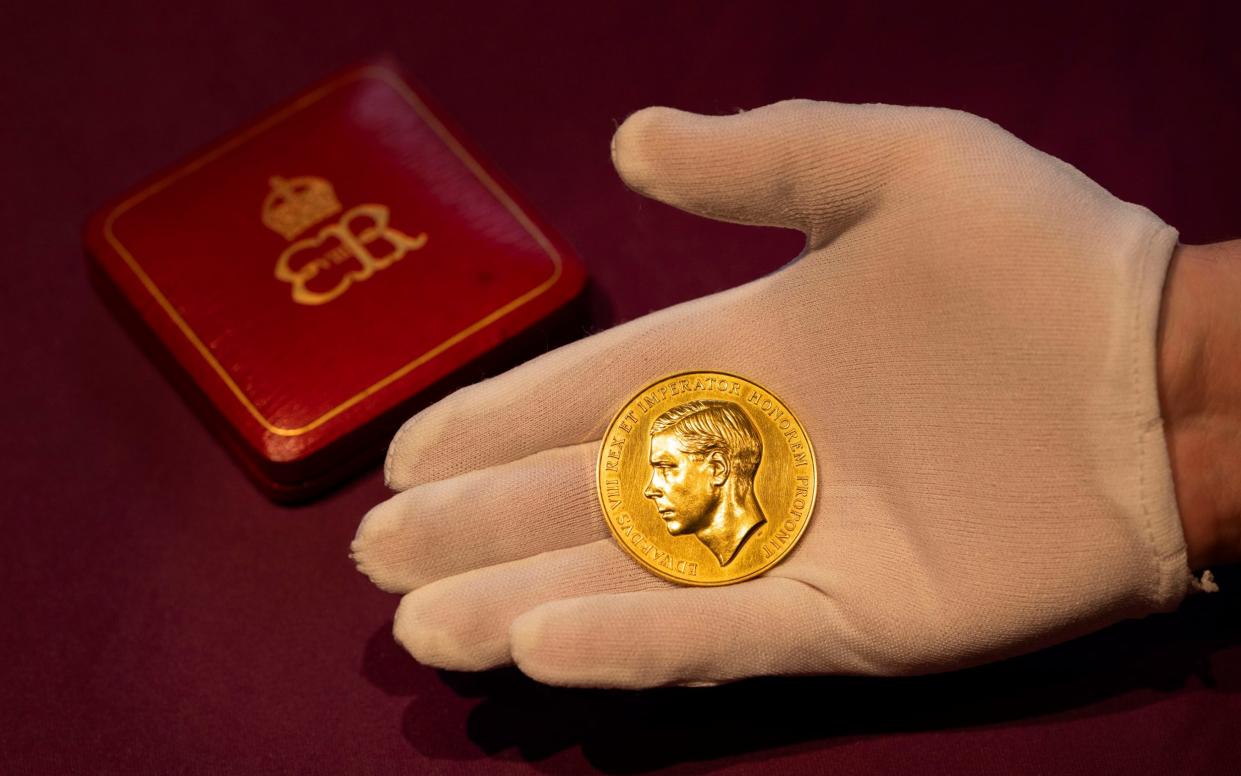Rare Edward VIII gold medal to go up for auction

- Oops!Something went wrong.Please try again later.
- Oops!Something went wrong.Please try again later.
- Oops!Something went wrong.Please try again later.
A rare gold medal featuring Edward VIII has emerged after an unsuspecting owner handed it to a pawnbroker.
The medal, thought to be one of just 26 in existence, bears the official Royal Mint effigy of the former king whose reign lasted under a year before he abdicated the throne.
“Whoever has pawned it has not appreciated its significance,” Gregory Edmund, a numismatic expert from Spink & Son auction house, told The Telegraph.
In January, it will become the fourth Duke of Windsor medal to ever go up for sale after it was given to a pawnbroker by an anonymous but suspected family friend or relative of the late recipient – scholar Christopher Seton-Watson.
Achievement medal
Mr Seton-Watson was awarded the prestigious accolade while a schoolboy at Winchester College, the alma mater of Prime Minister Rishi Sunak, to mark an achievement of distinction in Latin verse.
“It’s made that much more special because it is a Royal recognition of an individual scholar”, Mr Edmund said.
“I don’t think there was any close family left,” he said of Mr Seton-Watson, who died unmarried in 2007 after becoming a distinguished historian of Italy, teaching at Oxford University and founding the Association for the Study of Modern Italy.
He also had a decorated military career and was awarded the Military Cross before ending his time in the Army as a major.
Mr Edmund added: “When I discussed it with the pawnbrokers they said that it was a family friend or relative.
“But, of course, it’s just that extraordinary fall from grace of something so significant and nationally important.
“From a collector’s point of view, you don’t get an officially approved sanctioned and produced by the Royal Mint effigy of Edward VIII of this size, other than on these medals. And because they are only individual presentations, they very, very seldom come up for sale.”
The medal was pawned and later obtained by Spink & Son, which specialises in the sales of coins, banknotes, stamps and medals, in its original presentation box bearing the official Edward VIII cipher.
The cipher was rarely reproduced as the former king reigned for only 325 days before he abdicated the throne in December 1936 to marry the American divorcée Wallis Simpson.
The move sent shockwaves through the country and reshaped the future of the British monarchy, charting the course for the late Queen Elizabeth II and her father to take over the new line of succession.
Edward’s abdication also meant that Royal Mint coinage bearing his portrait was created in extremely limited numbers and never went into circulation.
“Because there was a sudden rush and a sudden change of the guard, a lot of the designs that had been approved for Edward VIII subsequently just migrated and became George VI,” Mr Edmund explained of the coin effigies made.
However, because of delays in ratifying the Duke of Windsor’s effigy for the Royal prize medals, recipients were handed a promissory note in the summer of 1936 saying they would receive them once produced.
“But, of course, they didn’t know the abdication would happen,” Mr Edmund said, adding: “So you have this bizarre situation where in March of 1937, the Royal Mint is having to get approval from King George to use the effigy of his brother in order to retrospectively apply prize medals for 1936. And so you get this bizarre distribution of Edward VIII gold medals in March of 1937, two months before George VI’s coronation.”
Latin markings
The medal is inscribed with Latin phrasing on the headside, meaning the design produced is unique to this prize.
The text translates to “the King and Emperor Edward VIII proposes this award”, which Mr Edmund explained makes it a “very specific Royal honour to this scholar, who wouldn’t have actually got it until after the abdication”.
According to Mr Edmund, Royal Mint’s historical notes suggest that this is one of 26 medals produced with Edward’s effigy for all of the different nautical colleges such as Dartmouth, Sandhurst and Winchester.
It will be sold in New York in January and Mr Edmund, who is in charge of the sale, has set an estimated price of £15,000 to £20,000 – though he expects it to go much higher.
“This medal really transcends the coin collecting or medal collecting world,” he said.
Explaining why he decided to put the medal up for auction in the US, he said: “It’s not quite the erudite academic scenario of London where people very much consider each purchase and look at it on the merits of the object itself.
“Here, I’m putting it in an audience where people are appreciating it more as a piece of art or a piece of national history.”
The Royal Mint was approached for comment by The Telegraph.

